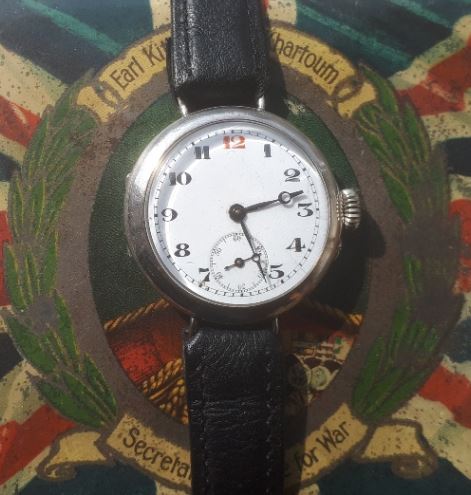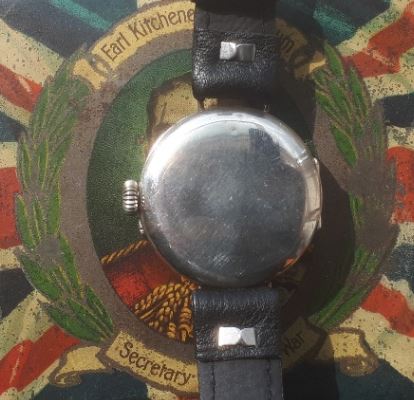Last updated on July 13, 2024
This antique Fonetainemelon silver trench watch has a hand-winding movement. It was made by the Swiss movement manufacturer Fabrique d’Horlogerie de Fontainemelon (FHF) and it is working very nicely. The watch is ticking loudly on my desk as I type. Fontainemelon was known for producing quality ébauche movements. The movement is protected by an inner hinged cover. It has Breguet style pin-set hands (one of which is a possible vintage replacement), a sub-seconds dial and outer minute markers. It’s an early trench watch and doesn’t include any luminous material on the dial.
Timing, during warfare, became important, particularly when trying to coordinate attacks against well-organised troops. During WW1 soldiers began to wear modified pocket watches on their wrists, with wire lugs soldered on that allowed wrist straps. These were much more practical than a pocket watch that was stored in a jacket pocket. A soldier could aim their rifle, and turn their wrist to tell the time. This was easier than digging through their tunic for their pocket watch. Wristwatches became common in the trenches. However, pocket watches continued to be used by the pilots in the Royal Flying Corps.
Note: This is a pin-set watch, the crown does not pull out. Press and hold the tiny button below the crown and turn to set the time.

Silver case
The watch measures 34mm in diameter, excluding the winding crown and the fixed wire lugs. The case material is silver and there are hallmarks inside both of the case backs for London (import mark) 1914. There is also a sponsor’s mark for George Stockwell (GS). From 1 June 1907, Stockwell acted as an assay agent, facilitating the import into Britain of foreign gold and silver items. All foreign imports had to be assayed and hallmarked in a UK assay office before being released for retail sale. The watch strap is a new genuine leather replacement.
Fonetainemelon movement
The watch has a hand-winding pin-set Swiss made 15-jewel movement by the movement manufacturer Fonetainemelon. It is working nicely, accurate to within a minute per day. A hinged dust cover protects the movement. Under magnification, I can see that the pallet jewels of the pallet fork are a yellowish colour, which is unexpected because all of my other watches have pink pallet jewels. The movement is in 95% mint condition, with only a few marks visible under magnification. When I first received the watch I didn’t notice the pin-set movement and tried in vain to pull out the crown. Fortunately, I realised my mistake before I caused any damage.

Condition
The case is in good condition for a timepiece that is over a hundred years old. There is some very slight unevenness to the outer hinged case back. The inner dust cover also has some very fine scratching. However, this is barely visible to the naked eye. Neither, of course, is visible when the watch is being worn. The acrylic watch lens has a little marking, but is very acceptable. The marks are only noticeable on close inspection in a good light. There is no damage to this watch, just the patina acquired with age. Finally, the enamel dial has a couple of faint hairline cracks, but these are only noticeable under magnification.

This antique Fonetainemelon silver trench watch is a delightful timepiece. It is small by today’s standards, but very useable as a dress watch. It feels very light on my wrist when compared to the much larger modern mechanical watches. I like to wear my watches and this one keeps excellent time, on par with some of my modern automatics. It has a reliable power reserve of just over twenty-four hours.
Related content
Fabrique d’Horlogerie de Fontainemelon (FHF) at Watch Wiki.
